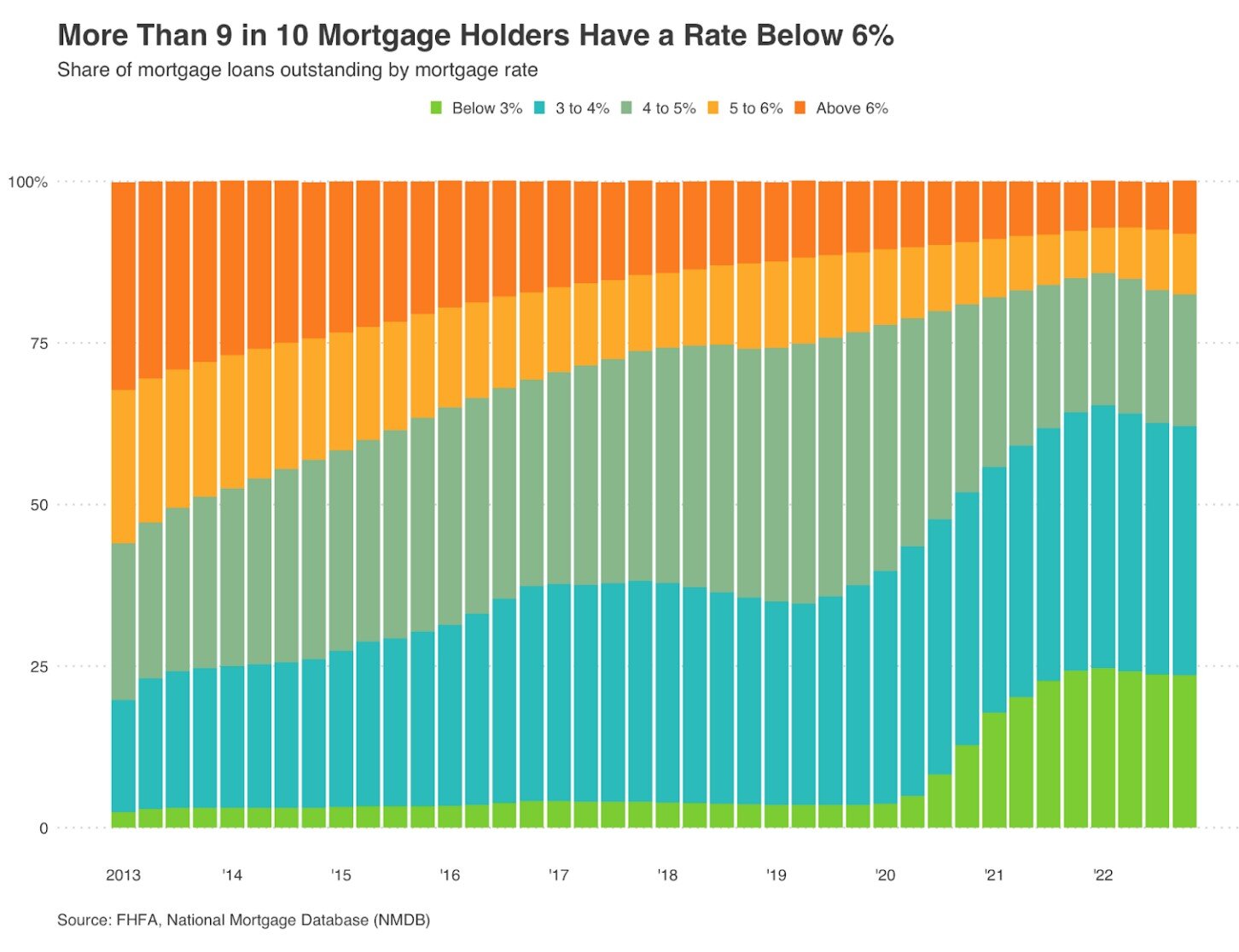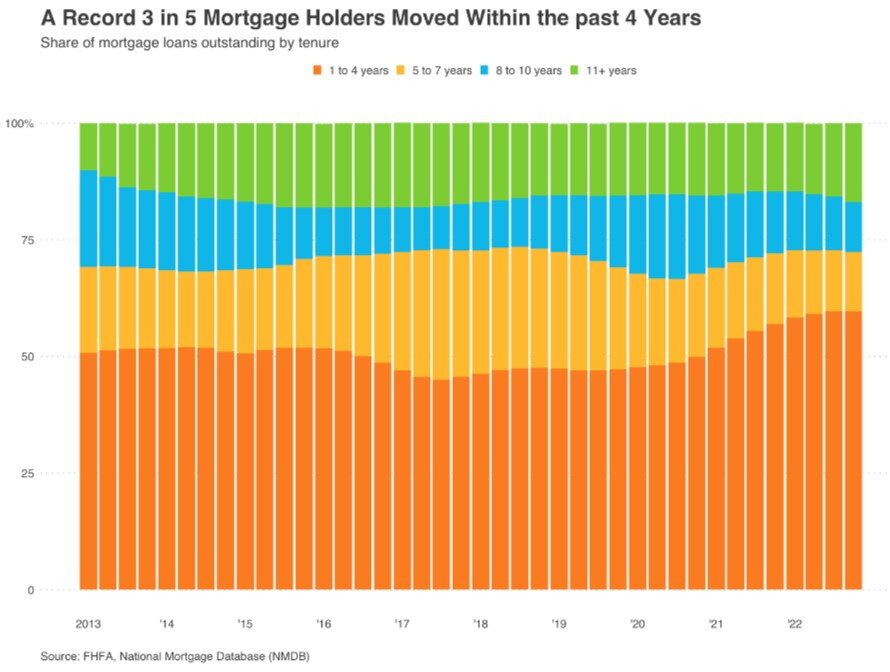Residential Real Estate News

Many Would Be U.S. Home Sellers Staying Put From High Mortgage Rates
Residential News » Seattle Edition | By WPJ Staff | June 15, 2023 8:59 AM ET
According to Redfin, more than nine of every 10 (91.8%) U.S. homeowners with mortgages have an interest rate below 6%. That is down just slightly from the record high of 92.9% hit in mid-2022.
That means well over 92% of homeowners with mortgages have mortgage rates below the current weekly average of 6.71%, which is near the highest level in over 20 years. Homeowners holding onto their comparatively low mortgage rates is the main reason for today's major shortage of new listings. Here's the full breakdown of where today's homeowners fall on the mortgage-rate spectrum:
- Below 6%: 91.8% of U.S. mortgaged homeowners have a rate below 6%, down from a record high of 92.9% in the second quarter of 2022.
- Below 5%: 82.4% have a rate below 5%. That's down from a peak of 85.7% in the first quarter of 2022.
- Below 4%: 62% have a rate below 4%, also down from a record high (65.3%) hit in the first quarter of 2022.
- Below 3%: 23.5% an interest rate below 3%, near the highest share on record. The highest was 24.6% in the first quarter of 2022.
Many would-be sellers are staying put rather than listing their home to avoid taking on a much higher mortgage rate when they purchase their next house. This "lock in" effect has pushed inventory down to record lows this spring. New listings of homes for sale and the total number of listings have both dropped to their lowest level on record for this time of year, which is fueling homebuyer competition in some markets and preventing home prices from falling further even amid tepid demand.
Even though the share of homeowners with mortgage rates below 5% or 6% has come down slightly because more people have bought homes with today's elevated rates, it's still true that nearly every homeowner would take on a higher mortgage rate if they moved. That's making most people who don't need to move stay put, which means it's slim pickings for buyers. Pending home sales are down about 17% from a year ago.
"High mortgage rates are a double whammy because they're discouraging both buyers and sellers-and they're discouraging sellers so much that even the buyers who are out there are having trouble finding a place to buy," said Redfin Deputy Chief Economist Taylor Marr. "The lock-in effect is unlikely to go away in the near future. Mortgage rates probably won't drop below 6% before the end of the year, and most homeowners wouldn't be motivated to sell unless rates dropped further. Some of them simply don't want to take on a 6%-plus mortgage rate and some can't afford to."
Just over one-quarter (27%) of U.S. homeowners who are considering listing their home in the next year would feel more urgency to sell if rates dropped to 5% or below. That's according to a Redfin survey conducted by Qualtrics in early June. Roughly half (49%) would feel more urgency if rates were to drop to 4% or below, and the share increases to 78% if they were to drop to 3% or below--a situation that is highly unlikely any time in the near future.
"The only people selling right now are the ones who need to," said Atlanta Redfin Premier agent Jasmine Harris. "The last three potential sellers I've met are people who are moving out of the country. I'm also working with someone who's moving out of town for a new job and another person who needs a smaller home for health reasons. So there are some homes coming on the market, but not nearly as many as there would be if rates weren't so high. In more typical times, we'd also have people selling simply because they wanted to move to a different neighborhood or wanted a bigger home and/or one with different features."
The typical monthly mortgage payment has increased $1,000 over the last three years as rates have risen from record lows and home prices have increased
The typical home buyer purchasing today's median-priced U.S. home (roughly $380,000) at the current average 6.7% mortgage rate would take on a monthly payment of roughly $2,600, a record high. That's up more than $300 from a year ago and up more than $1,000 from three years ago, using the median sale price and average mortgage rates from those time periods.
Nearly everyone has a mortgage rate below the one they would get if they bought a home today, but the difference in monthly payments varies depending on each individual situation. A mortgage holder in the 3% to 4% range is more likely to feel handcuffed to their home than someone in the 5% to 6% range, for instance.
A record share of mortgage holders have lived in their home for 4 years or less, further holding back supply
More than half of (59.7%) homeowners with mortgages have lived in their home for four years or less, a record high and up from 47.3% during the fourth quarter of 2019, just before the pandemic began.
The portion of people who haven't lived in their home long has shot up because so many people purchased homes during the pandemic, motivated by record-low mortgage rates and remote work. That means that even if rates were to drop significantly, it may not lead to a flood of new listings. Many people are likely to stay put simply because they moved recently and aren't in a hurry to move again.
Sign Up Free | The WPJ Weekly Newsletter
Relevant real estate news.
Actionable market intelligence.
Right to your inbox every week.
Real Estate Listings Showcase
Related News Stories
Residential Real Estate Headlines
- More Americans Opting for Renting Over Homeownership in 2024
- BLOCKTITLE Global Property Tokenization Platform Announced
- Small Investors Quietly Reshaping the U.S. Housing Market in Late 2024
- Greater Miami Overall Residential Sales Dip 9 Percent in November
- U.S. Home Sales Enjoy Largest Annual Increase in 3 Years Post Presidential Election
- U.S. Housing Industry Reacts to the Federal Reserve's Late 2024 Rate Cut
- U.S. Home Builders Express Optimism for 2025
- Older Americans More Likely to Buy Disaster-Prone Homes
- NAR's 10 Top U.S. Housing Markets for 2025 Revealed
- U.S. Mortgage Delinquencies Continue to Rise in September
- U.S. Mortgage Rates Tick Down in Early December
- Post Trump Election, U.S. Homebuyer Sentiment Hits 3-Year High in November
- Global Listings Aims to Become the Future 'Amazon of Real Estate' Shopping Platform
- Greater Las Vegas Home Sales Jump 15 Percent in November
- Ultra Luxury Home Sales Globally Experience Slowdown in Q3
- World Property Exchange Announces Development Plan
- Hong Kong Housing Market to Reach Equilibrium in Late 2025
- Construction Job Openings in U.S. Down 40 Percent Annually in October
- U.S. Mortgage Applications Increase in Late October
- World Property Markets, World Property Media to Commence Industry Joint-Venture Funding Rounds in 2025
- New Home Sales Hit 2 Year Low in America
- U.S. Pending Home Sales Increase for Third Consecutive Month in October
- Pandemic-led Residential Rent Boom is Now Fizzling in the U.S.
- Emerging Global Real Estate Streamer WPC TV Expands Video Programming Lineup
- 1 in 5 Renters in America Entire Paycheck Used to Pay Monthly Rent in 2024
- U.S. Home Sales Jump 3.4 Percent in October
- Home Buyers Negotiation Power Grows Amid Cooling U.S. Market
- Canadian Home Sales Surge in October, Reaching a Two-Year High
- Greater Orlando Area Home Sales Continue to Slide in October
- U.S. Mortgage Credit Availability Increased in October
- U.S. Mortgage Rates Remain Stubbornly High Post Election, Rate Cuts
- Construction Input Prices Continue to Rise in October
- BETTER MLS: A New Agent and Broker Owned National Listings Platform Announced
- Home Prices Rise in 87 Percent of U.S. Metros in Q3
- Caribbean Islands Enjoying a New Era of Luxury Property Developments
- The World's First 'Global Listings Service' Announced
- Agent Commission Rates Continue to Slip Post NAR Settlement
- Market Share of First Time Home Buyers Hit Historic Low in U.S.
- Greater Palm Beach Area Residential Sales Drop 20 Percent Annually in September
- Mortgage Applications in U.S. Dip in Late October







